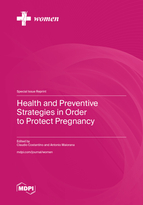Health and Preventive Strategies in Order to Protect Pregnancy
A special issue of Women (ISSN 2673-4184).
Deadline for manuscript submissions: closed (30 September 2023) | Viewed by 39051
Special Issue Editors
2. Vaccination Unit, University Hospital of Palermo, Palermo, Italy
Interests: vaccination; vaccines; vaccine hesitancy; vaccine outreach; vaccine communication; paediatric vaccination; adolescent vaccination; adult vaccination; elderly vaccination
Special Issues, Collections and Topics in MDPI journals
Interests: endometriosis; pregnancy outcomes; pregnant women; health of pregnant women; vaccination in pregnancy; prenatal screening; pregnancy management
Special Issue Information
Dear Colleagues,
Pregnancy is one of the most important times in a woman’s life. Maintaining the best possible health status during pregnancy is a key objective for public health in addition to gynecological, obstetrical, and reproductive sciences.
At least three vaccinations are strongly recommended in order to protect pregnancy (anti-influenza, anti-diphtheria, -tetanus, and -pertussis, and anti-COVID-19 vaccinations). TORCH agents represent a threat for pregnancy worldwide, and in some cases the more appropriate preventive strategies are just vaccinations (anti-measles, -mumps, -rubella, and -varicella, and anti-hepatitis B). HIV represents another problem during pregnancy worldwide. Moreover, the increasing age of pregnant women, especially in more developed countries, makes pregnancy increasingly complex. The necessity of prenatal screening is fundamental to date in order to avoid complications during pregnancy and during birth.
Finally, endometriosis, eclampsia, and pre-eclampsia are major challenges for gynecologists and women who desire to be pregnant.
In the present Special Issue of Women, we warmly welcome all original manuscripts, commentaries, reviews, systematic reviews, or meta-analyses that explore all of the fields related to pregnancy prevention, management, and outcomes.
Dr. Claudio Costantino
Dr. Antonio Maiorana
Guest Editors
Manuscript Submission Information
Manuscripts should be submitted online at www.mdpi.com by registering and logging in to this website. Once you are registered, click here to go to the submission form. Manuscripts can be submitted until the deadline. All submissions that pass pre-check are peer-reviewed. Accepted papers will be published continuously in the journal (as soon as accepted) and will be listed together on the special issue website. Research articles, review articles as well as short communications are invited. For planned papers, a title and short abstract (about 100 words) can be sent to the Editorial Office for announcement on this website.
Submitted manuscripts should not have been published previously, nor be under consideration for publication elsewhere (except conference proceedings papers). All manuscripts are thoroughly refereed through a single-blind peer-review process. A guide for authors and other relevant information for submission of manuscripts is available on the Instructions for Authors page. Women is an international peer-reviewed open access quarterly journal published by MDPI.
Please visit the Instructions for Authors page before submitting a manuscript. The Article Processing Charge (APC) for publication in this open access journal is 1000 CHF (Swiss Francs). Submitted papers should be well formatted and use good English. Authors may use MDPI's English editing service prior to publication or during author revisions.
Keywords
- pregnancy
- pregnancy health
- pregnant women
- preventive medicine
- vaccination in pregnancy
- maternal immunization
- endometriosis in pregnancy
- TORCH infections
- eclampsia
- pre-eclampsia
- prenatal screening
- pregnancy management
- pregnancy outcomes






